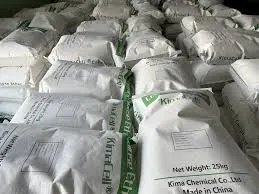
Oct . 07, 2024 04:14 Back to list
hydroxyethyl cellulose manufacturing process
Manufacturing Process of Hydroxyethyl Cellulose
Hydroxyethyl cellulose (HEC) is a water-soluble polymer derived from cellulose, a natural polymer primarily found in plant cell walls. HEC is widely used in various industries, including pharmaceuticals, cosmetics, and construction, due to its thickening, emulsifying, and film-forming properties. The manufacturing process of hydroxyethyl cellulose involves several key steps to ensure high quality and purity of the final product.
1. Raw Material Preparation
The production of hydroxyethyl cellulose begins with the selection and preparation of cellulose, which is typically sourced from wood pulp or cotton linters. The cellulose must be purified to remove any impurities that may interfere with the subsequent reactions. This involves using chemical treatments, such as alkaline digestion, followed by washing and bleaching to achieve a high degree of purity.
Once the raw cellulose is prepared, it undergoes an etherification process. This is the core step in HEC production, where ethylene oxide, a reactive gas, is introduced to the cellulose. The cellulose is first alkalized using sodium hydroxide or another basic catalyst to promote the reaction with ethylene oxide. The cellulose is then subjected to controlled heating and stirring conditions, allowing the ethylene oxide to react with the hydroxyl groups present on the cellulose chains. This reaction forms hydroxyethyl groups, resulting in the transformation of cellulose into hydroxyethyl cellulose.
3. Neutralization
hydroxyethyl cellulose manufacturing process

Following the etherification reaction, the next step is neutralization. The alkaline environment created during the etherification process must be neutralized to halt the reaction and stabilize the product. This is typically accomplished by adding an acid, such as hydrochloric acid, to the mixture. The pH is carefully monitored to achieve the desired level of neutralization without compromising the integrity of the HEC.
4. Precipitation and Washing
After neutralization, the HEC solution is subjected to precipitation. This is often done by adding a non-solvent, such as alcohol, to the reaction mixture, causing the HEC to precipitate out of the solution. The precipitate is then collected through filtration and thoroughly washed to remove any residual impurities and unreacted reagents.
5. Drying and Milling
The final steps in the manufacturing process involve drying and milling the hydroxyethyl cellulose. The washed precipitate is dried using controlled temperature and humidity conditions to prevent degradation of the material. Once dried, it is milled into a fine powder to enhance its solubility and functionality in various applications.
Conclusion
The manufacturing of hydroxyethyl cellulose is a meticulous process that requires careful control of each step to ensure the quality and performance of the final product. With its excellent thickening and stabilizing properties, HEC has become an essential ingredient in numerous formulations across different industries, demonstrating its versatility and importance in modern applications.
-
What is HPMC?
NewsJun.06,2025
-
Understanding Redispersible Powder: The Future of Construction Materials
NewsJun.06,2025
-
Understanding RDP Powder: The Ultimate Solution for Your Construction Needs
NewsJun.06,2025
-
Pure HPMC: The Ideal Solution for Modern Construction and Building Materials
NewsJun.06,2025
-
Methyl Hydroxyethyl Cellulose: A Versatile Chemical Compound
NewsJun.06,2025
-
Hydroxyethyl Cellulose Power: The Essential Chemical for Various Industries
NewsJun.06,2025







